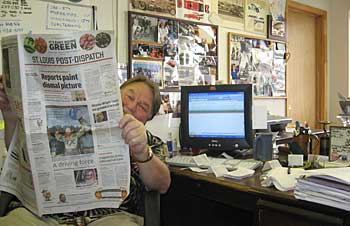Racing Net Source LLC
114 E. Elm St. , Ste. 8O'Fallon, MO 63366-2642
636.272.6301 / fax 636.272.0412

DRAG RACING Online will be published on the 8th of each month and will be updated throughout the month.
DRAG RACING Online owes allegiance to no sanctioning body and will call 'em as we see 'em. We strive for truth,integrity, irreverence and the betterment of drag racing. We have no agenda other than providing the drag racing public with unbiased information and view points they can't get in any other drag racing publication.
EDITORIAL |
|
Editor & Publisher, CEO |
Jeff Burk |
Managing Editor, COO |
Kay Burk |
Editor at Large |
Bret Kepner |
Editor at Large, Emeritus |
Chris Martin |
Bracket Racing Editor |
Jok Nicholson |
Nostalgia Editor |
Jeff Utterback |
Contributing Writers |
Jim Baker, Darr Hawthorne, |
Australian Correspondent |
Jon Van Daal |
European Correspondent |
Ivan Sansom |
Poet Laureate |
Bob Fisher |
Cartoonists |
Jeff DeGrandis Kenny Youngblood |
PHOTOGRAPHY |
|
Senior Photographer |
Ron Lewis |
Contributing Photographers |
|
PRODUCTION |
|
Creative Director/ Webmaster |
Matt Schramel |
Production Assistant |
Clifford Tunnell |
Site Programmer/ IT Consultant |
Adrienne Travis |
ADVERTISING |
|
| Director of Sales | Darr Hawthorne 818-424-6656 |
FINANCIAL |
|
| Accounts Manager, Chief Financial Officer | Casey Araiza |
- Agent 1320
- At the Back Door (caption contest)
- Letter to the Editor (for publication)
- New product press releases

© 2006-2020, Drag Racing Online
and Racing Net Source LLC

NHRA drag racing’s history and tradition is not measured in feet!
 Almost as soon as the NHRA made their announcement that the track for the Top Fuel and Funny Car classes would be reduced to 1,000 feet in an effort to make the racing in those classes safer for the driver and everybody else involved, some of those in drag racing immediately declared that the sport of drag racing had suffered a mortal blow. These folks are reacting as if Moses had come down from the mount with the words “A drag racing track is to be 1320 feet!”
Almost as soon as the NHRA made their announcement that the track for the Top Fuel and Funny Car classes would be reduced to 1,000 feet in an effort to make the racing in those classes safer for the driver and everybody else involved, some of those in drag racing immediately declared that the sport of drag racing had suffered a mortal blow. These folks are reacting as if Moses had come down from the mount with the words “A drag racing track is to be 1320 feet!”
The fact is that almost from the beginning of this sport more than 50 years ago, the distance of dragstrips have been determined by who built them and how long they wanted them to be. I have been told by some who knew him, that Wally Parks told people the quarter mile was the distance he chose for the drag strip because he and his cohorts had measured the distance between the stoplights of an Los Angeles city block and that distance was 1320 feet.
Throughout the history of the sport races have been conducted on tracks varying in length and surface from 300-ft dirt tracks to the half-mile NHRA-sanctioned drags at Riverside, California. A look at the history of the sport will show plenty of national events conducted on eighth- mile tracks. For years the National Dragster published class records for cars that ran both the quarter mile and the eighth mile.
So please, spare me the “Shortening the track goes against everything drag racing stands for and its history” wailing because that argument simply isn’t backed up by facts or history.
The NHRA has shortened the track temporarily to 1,000 feet because it was the only solution that could be achieved immediately without costing the already financially stressed teams even more money they don’t have. What would you have them do? Change the cubic inch rule, ban blowers, install spec fuel systems or ignitions before Denver without any benefit of testing to even see if the changes would work?
Understand that this decision to shorten the track to 1,000 feet came at the insistence and approval of a majority of the Top Fuel and Funny Car team owners and drivers. You can rest assured that a majority of those folks came to the conclusion that the risk/reward factor of racing nitro-burning, supercharged race cars 1320 feet on NHRA tracks wasn’t safe. The NHRA ultimately didn’t make the decision to shorten the track, the racers themselves did. So, if you want to hold someone responsible for this decision, aim your angst at the guys who actually take the risk and a majority of whom, in my opinion, decided the thrill of 330 miles per hour was no longer worth risking their lives for. Or better yet, ask their wives, kids, and friends.
The NHRA and a majority of the PRO agreed on shortening the tracks for T/F and F/C for a short-term and least-expensive fix, and I applaud their action.
Once again I want to address possible fixes so that NHRA national events might return to the quarter-mile length. I have heard from a lot of well-qualified people who want to reduce engine cubic inches, mandate smaller or single fuel pumps, and superchargers, restrict the engines to a single magneto, and plug or ban supercharged nitro engines altogether. All of these suggestions might eventually work, but there can be no doubt that they would cost the well-financed teams a lot of money for parts and research and development and might put some of the smaller teams completely out of the game, and right now the last thing drag racing needs is fewer fuel cars.
So, I’m going to say again there are two ways to slow down the cars and make quarter-mile racing safer and less expensive:
1. Reduce the aero packages on the Top Fuel and Funny Cars. Specifically the monstrous rear-wing packages on both types of cars. It’s simple physics really. The more down-force a car has on the drive wheels, the more power the tuner can use and the more stress is put on the internal engine parts. Of course the result is quicker and faster cars, but in today’s NHRA drag racing almost everyone can agree that the cars are too fast. A few inexpensive changes in the aero packages to take away some down-force would make quarter-mile racing for fuel cars viable again. Every major motor sport from NASCAR to F-1 has used aerodynamics to control the speed of their cars when they started going too fast. If you want to make fuel racing more affordable, take some of the down-force away so that you don’t have to make 8,000 horsepower to be competitive.
2. I’ve said it before and gotten my ass chewed for doing so, but I’m going to say it again. The simple, most cost-effective fix is to just quit prepping the tracks so much. Prep the first 60 feet to death if you wish, but just make the rest of the track clean, smooth and reasonably sticky. If you watched the race at Norwalk as I did then you would have noticed that 300-mph speeds were hard to come by. In fact, just one Top Fuel car went over 320 mph and a majority of nitro cars didn’t even break 300! The reason was that with all the rain the track management and the NHRA was unable to do the kind of prep they usually do. As a result the tuners and drivers had to step up their act and the result was some good racing and some “pedal fests” -- and what is wrong with that?
Let me tell you my little secret. I go to the drags for the racing. I don’t give a damn about acceleration contests and speed only slightly raises my blood pressure. I want to see good racing. If I want a speed fix I’ll go to Bonneville. Give me a tire-smoking pedal fest in every round where the driver’s skill is what wins the race. Give me a track where the tuner has to finesse the fuel system and clutch management to get the car down the track. Hell, I don’t care if the cars smoke the tires the entire length of the track, in fact I might like that better than what we are seeing today.
It’s drag racing, folks, not acceleration racing or speed racing it’s DRAG RACING and it’s time to get back to doing that. If we can do it safer and less expensively, why not at least try it?

Recent Stories
- Burk's Blast – NHRA drag racing’s history and tradition is not measured in feet![7/3/2008]
- Burk's Blast – Just Wondering: Speed, is that all there is?[6/30/2008]
- Burk's Blast - So many questions for the NHRA and IHRA[6/17/2008]
- Burk's Blast - What the hell is going on?[6/10/2008]
- Burk's Blast - Still Wondering[6/2/08]